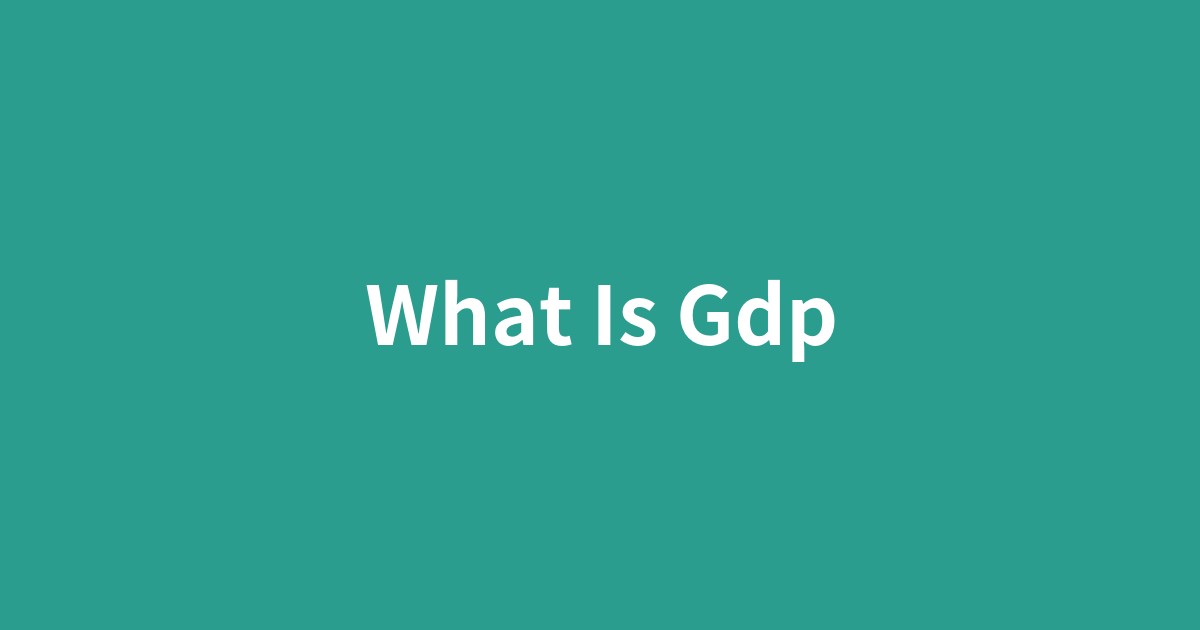このページは、歴史や文化の物語を楽しみながら、その文脈の中で重要な英単語を自然に学ぶための学習コンテンツです。各セクションの下にあるボタンで、いつでも日本語と英語を切り替えることができます。背景知識を日本語で学んだ後、英語の本文を読むことで、より深い理解と語彙力の向上を目指します。

ニュースで毎日聞くGDP。それが一体何をmeasure(測定)していて、国の経済状況をどう示しているのか、その基本をわかりやすく解説します。
この記事で抑えるべきポイント
- ✓GDP(国内総生産)とは、一定期間内に国内で新たに生み出された「付加価値」の総額であり、国の経済活動の規模を示す基本的な指標であること。
- ✓GDPは「生産」「分配」「支出」の三つの側面から測定でき、これらは理論上等しくなるという「三面等価の原則」が存在すること。
- ✓物価変動の影響を含む「名目GDP」と、その影響を取り除いた「実質GDP」があり、経済の真の成長を見るには実質GDPが重視されること。
- ✓GDPは経済規模を測る上で非常に有用な一方、家事労働や環境問題、人々の幸福度といった金銭に換算されない「豊かさ」は反映できないという限界があること。
GDP(国内総生産)とは何か ― 国の豊かさを測るモノサシ
「日本のGDP、世界4位に転落」― このようなニュースを耳にしたことはありませんか?私たちはGDPという言葉を日常的に聞きますが、それが具体的に何を意味し、私たちの生活にどう関わっているのか、深く考えたことはあるでしょうか。この記事では、国の経済的な健康診断書ともいえるGDPの正体に迫ります。一体、この指標は何を測定して(measure)いるのでしょうか。
What is GDP (Gross Domestic Product)? — A Yardstick for a Nation's Wealth
Have you ever heard news like, "Japan's GDP falls to 4th in the world"? We hear the term GDP on a daily basis, but have you ever deeply considered what it specifically means and how it relates to our lives? This article delves into the true nature of GDP, which can be described as a nation's economic health report. What exactly does this indicator measure?
GDPとは何か?― 国の経済規模を示す「付加価値」の合計
まず、GDP(Gross Domestic Product)の基本的な定義から見ていきましょう。GDPとは「一定期間内に、国内で新たに生み出されたモノやサービスの価値(value)の合計額」のことです。例えば、あるパン屋が100円で小麦粉を仕入れ、それを加工して300円のパンとして販売したとします。このとき、パン屋が生み出した「付加価値」は、販売価格から原材料費を引いた200円です。国内のあらゆる生産活動で生まれたこの付加価値をすべて合計したものがGDPとなり、国の経済活動全体の規模を示すのです。
What is GDP? — The Total of "Value Added" That Shows the Scale of a Nation's Economy
First, let's look at the basic definition of GDP (Gross Domestic Product). GDP is "the total value of goods and services newly created within a country during a specific period." For example, consider a bakery that buys flour for 100 yen and sells bread for 300 yen. The "value added" created by the bakery is 200 yen, which is the selling price minus the cost of raw materials. The sum of this value added from all productive activities in the country is the GDP, and it indicates the scale of the nation's entire economic activity.
経済を見る3つのメガネ ― 生産、分配、支出の「三面等価の原則」
GDPは一つの指標ですが、実は3つの異なる側面から捉えることができます。それが「生産」「分配(所得)」「支出」であり、この3つの視点から計算したGDPは理論上等しくなるという「三面等価の原則」が存在します。誰かがモノやサービスを生産すれば(produce)、それは付加価値として企業の利益や従業員の給料、つまり誰かの所得(income)になります。そして、その得られた所得は、最終的に個人消費や企業の投資といった形で誰かによって支出(expenditure)されます。この生産→分配→支出という循環を理解することで、経済の全体像を立体的に捉えることができるのです。
Three Lenses to View the Economy — The Principle of Three-Sided Equivalence of Production, Distribution, and Expenditure
Although GDP is a single indicator, it can actually be viewed from three different aspects: "production," "distribution (income)," and "expenditure." The "Principle of Three-Sided Equivalence" states that GDP calculated from these three perspectives is theoretically equal. When someone produces goods or services, it becomes someone's income, such as corporate profits or employee salaries. Then, that income is eventually used as expenditure for personal consumption or corporate investment. Understanding this cycle of production → distribution → expenditure allows us to grasp the overall picture of the economy in a three-dimensional way.
数字のトリック?― 「名目GDP」と「実質GDP」の違い
GDPのニュースを見る際に非常に重要なのが、「名目」と「実質」の違いです。物価の変動をそのまま反映した数値が「名目GDP」であり、その物価変動の影響を取り除いたものが「実質GDP」です。例えば、物価が全体的に上昇するインフレーション(inflation)が起こり、モノの値段が2倍になったとしましょう。たとえ生産量が同じでも、名目GDPは見かけ上2倍に膨れ上がります。しかし、これは経済が本当に豊かになったことを意味しません。国の真の経済的な成長(growth)を測るためには、物価変動の影響を排除した実質GDPの動きを見ることが不可欠なのです。
A Trick of Numbers? — The Difference Between "Nominal GDP" and "Real GDP"
When looking at GDP news, the distinction between "nominal" and "real" is crucial. "Nominal GDP" is the figure that includes price fluctuations, while "Real GDP" is the figure with the effects of price fluctuations removed. For example, if inflation occurs and the price of everything doubles, nominal GDP will appear to double even if the production volume remains the same. However, this does not mean the economy has truly become wealthier. To measure a country's true economic growth, it is essential to look at the movement of real GDP, which excludes the impact of price changes.
GDPだけでは測れない「豊かさ」― 指標の限界と新しい視点
GDPは経済規模を測る上で非常に強力な指標(indicator)ですが、決して万能ではありません。例えば、市場で金銭的な取引が行われない家事労働や育児、ボランティア活動などは、私たちの生活に不可欠な価値を持ちながらもGDPには含まれません。また、経済活動の裏側で進行する環境破壊のコストや、国民一人ひとりの幸福度、所得格差といった、数字では表しにくい「豊かさ」の側面も反映しにくいという限界があります。GDPというモノサシの強みと限界の両方を認識することが、社会をより深く理解する鍵となります。
The "Wealth" GDP Cannot Measure — The Limits of the Indicator and New Perspectives
GDP is a very powerful indicator for measuring the size of an economy, but it is by no means perfect. For example, activities not traded in the market, such as housework, childcare, and volunteer work, have essential value in our lives but are not included in GDP. Furthermore, it has limitations in reflecting aspects of "wealth" that are difficult to quantify, such as the environmental costs of economic activity, the happiness of citizens, and income inequality. Recognizing both the strengths and limitations of the GDP yardstick is key to a deeper understanding of society.
結論
この記事では、GDPが国内で生み出された付加価値の合計であり、三面等価の原則や名目・実質の違いを通じて、国の経済(economy)を多角的に理解するためのツールであることを学びました。同時に、GDPが私たちの感じる全ての「豊かさ」を測るわけではないという重要な限界も見てきました。GDPという指標を正しく理解することは、日々のニュースの裏側を読み解き、社会の動向を自分自身の視点で考えるための、確かな第一歩と言えるでしょう。
Conclusion
In this article, we learned that GDP is the sum of value added created domestically and that it is a tool for understanding a nation's economy from multiple angles through the principle of three-sided equivalence and the differences between nominal and real GDP. At the same time, we also saw the important limitation that GDP does not measure all aspects of the "wealth" we feel. Correctly understanding the GDP indicator is a solid first step toward reading between the lines of daily news and thinking about societal trends from your own perspective.
テーマを理解する重要単語
domestic
GDPの「D (Domestic)」が意味する「国内の」を理解するために不可欠です。これにより、GDPが国籍を問わず「国内で」生み出された価値を合計する指標であることが明確になります。また「家庭の」という意味もあり、GDPに含まれない家事労働の価値を考えるきっかけにもなります。
文脈での用例:
The airline offers both domestic and international flights.
その航空会社は国内線と国際線の両方を提供しています。
produce
GDPの三面等価の原則における「生産」の側面を担う単語です。記事では動詞「生産する」が中心ですが、名詞ではアクセントが前に移動し「農産物」を意味します。この違いを知ることは、経済記事の正確な読解に繋がり、GDPの「P (Product)」の理解を深めます。
文脈での用例:
The local market sells fresh farm produce.
その地元の市場では、新鮮な農産物が売られています。
growth
国の真の経済的な豊かさを測る上で、この記事が最も重視する概念です。物価変動の影響を除いた実質GDPの増加こそが、本質的な「経済成長」を示します。この単語は、単なる数字の増減ではなく、国の経済力の向上というニュアンスを捉えるために重要です。
文脈での用例:
The company has experienced rapid growth over the last two years.
その会社は過去2年間で急速な成長を遂げました。
value
GDPの定義の核となる「付加価値(value added)」を理解するための必須単語です。この記事ではモノやサービスの金銭的「価値」を指しますが、動詞として「重んじる」という意味も知っておくと、GDPでは測れない幸福度などの「価値」について考える際の視野が広がります。
文脈での用例:
She values honesty above all else.
彼女は何よりも正直さを重んじる。
income
三面等価の原則における「分配」面を理解する上で不可欠な単語です。生産された価値が、企業の利益や従業員の給料といった誰かの「所得」になるという経済の循環を示します。この単語は、GDPが国民の豊かさにどう繋がるのかを考えるための重要なキーワードとなります。
文脈での用例:
His monthly income is not enough to support his large family.
彼の月収は、大家族を養うには十分ではありません。
measure
記事冒頭で「この指標は何を測定しているのか」と問いかけ、GDPの本質に迫る重要な動詞です。名詞では「措置」や「尺度」の意味も持ち、経済ニュースで頻出します。この単語を理解することで、GDPが経済を測る「モノサシ」であるという比喩がより深く理解できます。
文脈での用例:
Protagoras's famous phrase is "Man is the measure of all things."
プロタゴラスの有名な言葉は「人間は万物の尺度である」です。
economy
記事全体のテーマである「経済」を指す中心的な単語です。「国の経済」というマクロな意味だけでなく、「節約」や飛行機の「エコノミークラス」といったミクロな意味も持ちます。この多義性を知ることで、GDPが論じる「経済」のスケール感をより正確に把握できます。
文脈での用例:
The government is trying to stimulate the national economy.
政府は国家経済を刺激しようと試みている。
inflation
名目GDPと実質GDPの違いを理解するための鍵となる概念です。物価が継続的に上昇する「インフレ」が起きると、生産量が変わらなくても名目GDPは見かけ上増加します。この記事の文脈では、数字の裏に隠された真の経済成長を見抜くために欠かせない知識と言えます。
文脈での用例:
The country is currently experiencing high inflation.
その国は現在、高いインフレーションを経験している。
expenditure
三面等価の原則の「支出」面を表す、経済学の基本用語です。所得(income)が最終的に個人消費や企業の投資といった「支出」に使われる流れを捉えるために必須です。この単語を知ることで、生産・分配・支出という経済の大きな循環構造を立体的に理解できます。
文脈での用例:
The government is trying to cut public expenditure.
政府は公共支出を削減しようとしています。
real
「名目GDP」と対になる「実質GDP」を構成する単語です。経済学の文脈では「物価変動の影響を取り除いた」という意味で使われ、国の真の経済成長を測るための指標であることを示します。「本物の」という根源的な意味を知ることで、なぜ「実質」GDPが重要視されるのかが直感的に理解できます。
文脈での用例:
The real problem is not a lack of resources, but a lack of will.
本当の問題は資源の不足ではなく、意志の欠如です。
indicator
GDPが経済状態を示す「指標」であることを明確にする単語です。この記事では、GDPが万能ではないという限界も指摘しており、この単語を通じて、GDPを絶対的なものではなく、数ある経済指標の一つとして客観的に捉える視点を養うことができます。様々な社会事象を分析する際に役立つ語彙です。
文脈での用例:
Consumer confidence is a key indicator of the country's economic health.
消費者信頼感は、その国の経済の健全性を示す重要な指標です。
nominal
実質GDPとの対比で使われる「名目GDP」を理解するための専門用語です。「名目上の」という意味が基本で、この記事では「物価変動をそのまま反映した、見かけ上の」というニュアンスで使われます。経済ニュースを正確に読み解く上で、real(実質)との違いを把握することが極めて重要です。
文脈での用例:
He is the nominal head of the company, but his wife holds the real power.
彼はその会社の名目上のトップだが、実権は彼の妻が握っている。